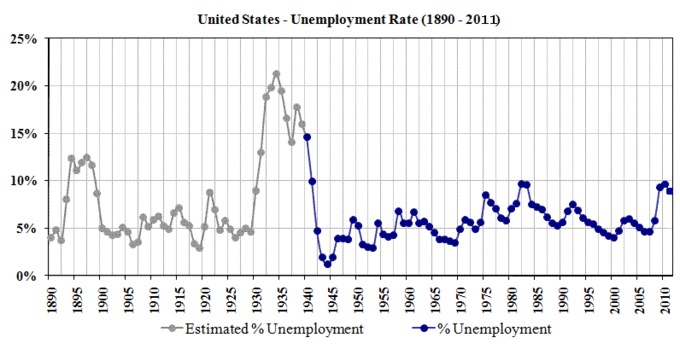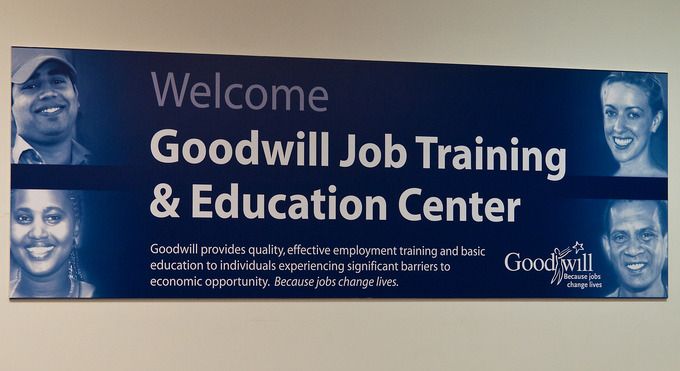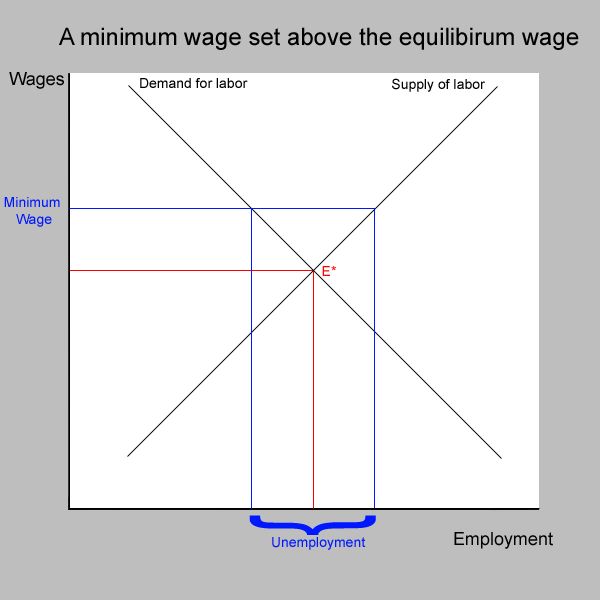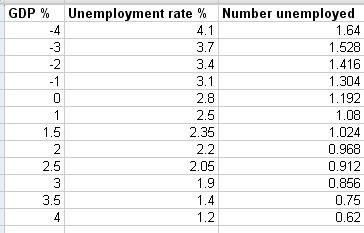Reasons for Unemployment
There are three reasons for unemployment which are categorizes as frictional, structural, and cyclical unemployment.
learning objectives
- Explain why the unemployment rate may fluctuate
There are four types of unemployment. The distinction between them is important to economists because the policy prescriptions for addressing each type vary.
Natural Level of Unemployment
The natural level of unemployment is the unemployment rate when an economy is operating at full capacity. This is the unemployment rate that occurs when production is at its long-run level, removing any temporary fluctuations and frictions. It is mainly determined by an economy’s production possibilities and economic institutions. At this level of unemployment, the quantity of labor supplied equals the quantity of labor demanded, though this does not imply that unemployment is zero. The reason why the natural rate of unemployment is still positive is due to frictional and structural unemployment.
Frictional Unemployment
Frictional unemployment is the time period between jobs when a worker is searching for or transitioning from one job to another. It is sometimes called search unemployment and can be voluntary based on the circumstances of the unemployed individual. Frictional unemployment exists because both jobs and workers are heterogenous, and a mismatch can result between the characteristics of supply and demand. Such a mismatch can be related to skills, payment, work-time, location, seasonal industries, attitude, taste, and a multitude of other factors.
There is always at least some frictional unemployment in an economy, so the level of involuntary unemployment is properly the unemployment rate minus the rate of frictional unemployment.
Though economists accept that some frictional unemployment is okay because both potential workers and employers take some time to find the best employee-position match, too much frictional unemployment is undesirable. Governments will seek ways to reduce unnecessary frictional unemployment through multiple means including providing education, advice, training, and assistance such as daycare centers.
Structural Unemployment
Structural unemployment is a form of unemployment where, at a given wage, the quantity of labor supplied exceeds the quantity of labor demanded, because there is a fundamental mismatch between the number of people who want to work and the number of jobs that are available. The unemployed workers may lack the skills needed for the jobs, or they may not live in the part of the country or world where the jobs are available. It is generally considered to be one of the “permanent” types of unemployment, where improvement if possible, will only occur in the long run.
A common cause of structural unemployment is technological change. With the advent of telephones, for example, some telegraph operators were put out of work. Their inability to find work was due to an oversupply of skilled telegraph operators relative to the demand for workers with that ability.
Cyclical Unemployment
Of course, the economy may not be operating at its natural level of employment, so unemployment may be above or below its natural level. This is often attributed to the business cycle: the expansion and contraction of the economy around the long-term growth trend. During periods in the business cycle when the economy is producing below its long-run, optimum level, firms demand fewer workers and the result is cyclical unemployment. In this case the long-run demand for labor is higher than the temporary demand, so the rate of unemployment is higher than its natural rate.

U.S. Unemployment Rate: The short-term fluctuations in the graph are the result of cyclical unemployment that changes when economic activity is above or below its long-term potential. Over time, unemployment has returned to about 5%, which is the approximate natural rate of unemployment.
Impact of Public Policy on Unemployment
Public policy seeks to minimize unemployment by providing information, training, facilities, and other programs to assist the unemployed.
learning objectives
- Review the importance of unemployment benefits in the American social welfare program
Most governments strive to achieve low levels of unemployment. However, the types of policies differ depending on what type of unemployment they address.
Frictional Unemployment
Frictional unemployment is the period between jobs in which an employee is searching for or transitioning from one job to another. It exists because the labor market is not perfect and there may be mismatches between job-seekers and jobs before workers are hired for the right position. If the search takes too long and mismatches are too frequent, the economy suffers, since some work will not get done.
Governments can enact policies to try to reduce frictional unemployment. These include offering advice and resources for job-seekers and providing clear and transparent information on available jobs and workers. This can take the form of free career counseling and job boards or job fairs. The government can provide facilities to increase availability and flexibility – for example, providing daycare may allow part-time or non-workers to transition into full-time jobs, and public transportation may widen the number of jobs available to somebody without a car. The government may also fund publicity campaigns or other programs to combat prejudice against certain types of workers, jobs, or locations.
On the other hand, some frictional unemployment is a good thing – if every worker was offered, and accepted, the first job they encountered, the distribution of workers and jobs would be quite inefficient. Many governments offer unemployment insurance to both alleviate the short-term hardship faced by the unemployed and to allow workers more time to search for a job. These benefits generally take the form of payments to the involuntarily unemployed for some specified period of time following the loss of the job. In order to achieve the goal of reducing frictional unemployment, governments typically require beneficiaries to actively search for a job while receiving payments and do not offer unemployment benefits to those who are fired or leave their job by choice.
Structural Unemployment
Structural unemployment is due to more people wanting jobs than there are jobs available. The unemployed workers may lack the skills needed for the jobs, or they may not live in the part of the country or world where the jobs are available.
Public policy can respond to structural unemployment through programs like job training and education to equip workers with the skills firms demand. A worker who was trained in an obsolete field, such as a typesetter who lost his job when printing was digitized, may benefit from free retraining in another field with strong demand for labor.

Job Training Programs: Many organizations seek to minimize structural unemployment by offering job training and education to provide workers with in-demand skills.
Impact of Unions on Unemployment
If the labor market is competitive, unions will typically raise wages but increase unemployment.
learning objectives
- Discuss the impact of unionization on unemployment
A union is a formal organization of workers who have banded together to achieve common goals such as protecting the integrity of its trade, achieving higher pay, increasing the number of employees an employer hires, and better working conditions. They function by negotiating with employers to create a collective agreement that applies to all union members and typically lasts for a set time period. For example, in a unionized industry, rather than each employee negotiating his or her own vacation time with the employer, a union will negotiate with the firm in order to create a contract governing vacation time that applies to every union member. This gives workers as a whole a stronger bargaining position when negotiating working conditions and pay.
Trade unions in their current form became popular during the industrial revolution, when most jobs required little skill or training and therefore almost all of the bargaining power fell with employers rather than employees. While unions have many goals, their primary objective has historically been to achieve higher wages for members of the union – that is, those who are already employed in an industry.
Unions are able to raise wages because, when they are powerful, they may turn the labor market into a monopoly market. Rather than a competitive market with many buyers (employers) and sellers (employees), there are many buyers but only one seller: the union. Like any monopoly market, the outcome will be an equilibrium with higher prices and lower supply than in the competitive equilibrium. In the case of the labor market, this means that wages will be higher, but so will unemployment. This is illustrated in the graphic, in which a union successfully raises the wage rate above the equilibrium wage. The gap between the point where the new wage rate intersects the demand curve and where it intersects the supply curve represents the resulting unemployment.

Raising Wages Above Equilibrium: If a union is able to raise the minimum wage for their members above the equilibrium wage, then wages will be higher but fewer workers will be employed.
Many economists criticize unionization, arguing that it frequently produces higher wages at the expense of fewer jobs. Essentially, unionization benefits the already employed at the expense of the unemployed. Further, by charging higher prices than the equilibrium wage rate, unions promote deadweight loss. Critics also argue that if some industries are unionized and others are not, wages will decline in non-unionized industries.
Unions in Imperfect Labor Markets
The above arguments assume that without unions, the labor market would be competitive – that is, there would be many buyers and many sellers of labor. In this competitive equilibrium, the wage rate would equal the marginal revenue product of labor and the outcome would be efficient. In reality this is often not the case. Rather, many industries are dominated by only a few firms, making the labor market an oligopsony – a market with many sellers of labor but only a few buyers. In an oligopsony firms have the advantage over workers, and wages may be lower than they would be at the competitive equilibrium.
If we assume that the labor market is imperfect and that wages are naturally lower than the marginal revenue product of labor, unions may increase efficiency by raising wage rates closer to the efficient level. In this case, wages will rise without a resulting rise in unemployment.
Unions, Productivity, and Unemployment
The above arguments focus on how unions affect unemployment by negotiating for higher wages, but unions may also affect unemployment in other ways. Many argue that unions are capable of raising productivity by reducing turnover, increasing coordination between workers and management, and by increasing workers’ motivation. More productive workers means a higher marginal product of labor. Since the demand for labor is determined by its marginal product, increased productivity will cause demand to shift to the right and lead to an efficient equilibrium with both higher wages and lower unemployment.
Efficiency Wage Theory
Efficiency wage theory is the idea that firms may permanently hold to a real wage greater than the equilibrium wage.
learning objectives
- Define Efficiency Wage Theory
Efficiency-Wage Theory
The market-clearing wage is the wage at which supply equals demand; there is no excess supply of labor (unemployment) and no excess demand for labor (labor shortage). In the basic economic theory, in the long run the economy will achieve this market-clearing equilibrium and will experience the natural level of unemployment. However, firms may choose to pay wages higher than the market-clearing equilibrium in order to incentivize increased worker productivity or to reduce turnover. This is called efficiency-wage theory.
Why Pay Efficiency Wages?
There are several theories of why managers might pay efficiency wages:
- Avoiding shirking: If it is difficult to measure the quantity or quality of a worker’s effort, there may be an incentive for him or her to “shirk” (do less work than agreed). The manager thus may pay an efficiency wage in order to increase the cost of job loss, which gives a sting to the threat of firing. This threat can be used to prevent shirking.
- Minimizing turnover: As mentioned above, by paying above-market wages, the worker’s motivation to leave the job and look for a job elsewhere will be reduced. This strategy makes sense when it is expensive to train replacement workers.
- Selection: If job performance depends on workers’ ability and workers differ from each other in those terms, firms with higher wages will attract more able job-seekers, and this may make it profitable to offer wages that exceed the market clearing level.
Consequence of Efficiency Wage
The consequence of the efficiency wage theory is that the market for labor does may not clear and unemployment may be persistently higher than its natural rate. Instead of market forces causing the wage rate to adjust to the point at which supply equals demand, the wage rate will be higher and supply will exceed demand. This produces higher wages for those who are employed but higher levels of unemployment.
Job Creation and Destruction
Jobs are created when workers become more productive, the price of output increases, or when total economic output increases.
learning objectives
- Summarize how jobs are created and destroyed on a firm, industry, and economy wide level
Job Creation at the Microeconomic Level
Firms decide to create or lose jobs based on the price of output, the price of inputs, and the marginal productivity of inputs. Firms will continue to demand labor until the marginal revenue product of labor equals the wage rate – that is, until the marginal benefit of one more employee equals the marginal cost of that employee. For example, suppose a shoe factory can sell shoes for $50 a pair, and hiring an additional employee to work for an hour allows the factory to produce one extra pair of shoes. As long as the wage rate is less than $50/hour, the firm can increase its profit by hiring more worker and producing more shoes. Eventually, however, the factory will become crowded, workers will need to wait in line for access to necessary tools and machinery, or the supply of materials will fail to keep up with the production pace. This will cause the marginal productivity of labor to fall, so that an additional hour of work produces less than one extra pair of shoes. If the prevailing wage rate is $25/hour, the firm will hire until it takes two hours of work to produce one pair of shoes. At this point, the marginal benefit of hiring labor is $25, equal to the marginal cost.
Factors that increase the productivity of labor will increase demand for labor and create jobs. Suppose a new type of sewing machine is invented that is smaller and allows shoemakers to work more quickly. This increases the productivity of labor, so that at its previous employment levels the firm can now earn $35 for every hour of labor it employs. Just as before, the firm will create more jobs and continue to hire until the marginal revenue product of labor is again equal to the wage rate. Similarly, if the price of output rises firms will hire more employees. If the price of shoes increases to $60, for example, workers that were previously making $25 worth of shoes in an hour will be making $30 worth of shoes each hour instead. Since the wage rate is still $25, the firm will hire more workers until the marginal revenue product of labor is equal to the wage rate.
Job Creation at the Macroeconomic Level
At a macroeconomic level, jobs are created when the general level of output rises and jobs are destroyed when the general level of output falls. The quantity of labor employed and the wage rate are determined by the intersection of labor supply (the number of people willing to enter the workforce at any given wage) and the labor demand (the amount of labor producers are willing to employ at any given wage rate). Labor supply is based primarily upon the size of the population and therefore remains fairly stable. The labor demand, however, shifts to the left when an economy’s output falls, since firms will need fewer workers to produce fewer goods. Likewise, labor demand shifts to the right when an economy’s output rises. These shifts will destroy job and lower wages or create jobs and increase wages, respectively.

Output and Employment: As this hypothetical graph shows, when output (GDP) is rising, jobs are created and unemployment falls. When output is falling, jobs are destroyed and unemployment rises.
One reason that economic activity might rise or fall is the business cycle. The business cycle refers to the periods of expansions and contractions in the level of economic activities around the long-term growth trend. This is typically due to an increase or decrease in the economy-wide demand for consumer goods, but these cycles could also take place due to changes in production technology, changes in governmental policy, and many other factors.
At the macroeconomic level jobs may also shift between industries due to changes in demand or technology. For example, when health researchers uncovered facts about the health risks of smoking, the demand for cigarettes dropped and many jobs were lost in the tobacco industry. As for technology, the invention of the telephone created many jobs in telecommunications, but destroyed most of the jobs associated with telegraphs.
Key Terms
- structural unemployment: A mismatch between the requirements of the employers and the properties of the unemployed.
- frictional unemployment: When people being temporarily between jobs, searching for new ones.
- cyclical unemployment: A type of unemployment explained by the demand for labor going up and down with the business cycle.
- unemployment insurance: Insurance against loss of earnings during the time that an able-bodied worker is involuntarily unemployed.
- bargaining power: The ability to influence the setting of prices or wages, usually arising from some sort of monopoly or monopsony position — or a non-equilibrium situation in the market.
- oligopsony: An economic condition in which a small number of buyers exert control over the market price of a commodity.
- marginal product of labor: the change in output that results from employing an added unit of labor.
- shirking: To provide less quality work than is required.
- turnover: The number of times a worker is replaced after leaving.
- marginal productivity: The extra output that can be produced by using one more unit of the input
- business cycle: A fluctuation in economic activity between growth and recession.
LICENSES AND ATTRIBUTIONS
CC LICENSED CONTENT, SHARED PREVIOUSLY
- Curation and Revision. Provided by: Boundless.com. License: CC BY-SA: Attribution-ShareAlike
CC LICENSED CONTENT, SPECIFIC ATTRIBUTION
- structural unemployment. Provided by: Wiktionary. Located at: en.wiktionary.org/wiki/structural_unemployment. License: CC BY-SA: Attribution-ShareAlike
- Unemployment. Provided by: Wikipedia. Located at: en.Wikipedia.org/wiki/Unemployment. License: CC BY-SA: Attribution-ShareAlike
- Structural Unemployment. Provided by: Wikipedia. Located at: en.Wikipedia.org/wiki/Structural_unemployment. License: CC BY-SA: Attribution-ShareAlike
- frictional unemployment. Provided by: Wiktionary. Located at: en.wiktionary.org/wiki/frictional_unemployment. License: CC BY-SA: Attribution-ShareAlike
- cyclical unemployment. Provided by: Wiktionary. Located at: en.wiktionary.org/wiki/cyclical_unemployment. License: CC BY-SA: Attribution-ShareAlike
- US Unemployment 1890-2011. Provided by: Wikipedia. Located at: en.Wikipedia.org/wiki/File:US..._1890-2011.gif. License: CC BY-SA: Attribution-ShareAlike
- structural unemployment. Provided by: Wiktionary. Located at: en.wiktionary.org/wiki/structural_unemployment. License: CC BY-SA: Attribution-ShareAlike
- Unemployment. Provided by: Wikipedia. Located at: en.Wikipedia.org/wiki/Unemplo...g_unemployment. License: CC BY-SA: Attribution-ShareAlike
- Frictional unemployment. Provided by: Wikipedia. Located at: en.Wikipedia.org/wiki/Frictional_unemployment. License: CC BY-SA: Attribution-ShareAlike
- Structural unemployment. Provided by: Wikipedia. Located at: en.Wikipedia.org/wiki/Structural_unemployment. License: CC BY-SA: Attribution-ShareAlike
- frictional unemployment. Provided by: Wiktionary. Located at: en.wiktionary.org/wiki/frictional_unemployment. License: CC BY-SA: Attribution-ShareAlike
- unemployment insurance. Provided by: Wiktionary. Located at: en.wiktionary.org/wiki/unemployment_insurance. License: CC BY-SA: Attribution-ShareAlike
- US Unemployment 1890-2011. Provided by: Wikipedia. Located at: en.Wikipedia.org/wiki/File:US..._1890-2011.gif. License: CC BY-SA: Attribution-ShareAlike
- Burien Goodwill Job Training & Education Center | Flickr - Photo Sharing!. Provided by: Flickr. Located at: www.flickr.com/photos/aboyand...ke/4427456559/. License: CC BY: Attribution
- Opposition to trade unions. Provided by: Wikipedia. Located at: en.Wikipedia.org/wiki/Opposition_to_trade_unions. License: CC BY-SA: Attribution-ShareAlike
- Trade union. Provided by: Wikipedia. Located at: en.Wikipedia.org/wiki/Trade_union. License: CC BY-SA: Attribution-ShareAlike
- marginal product of labor. Provided by: Wikipedia. Located at: en.Wikipedia.org/wiki/margina...t%20of%20labor. License: CC BY-SA: Attribution-ShareAlike
- oligopsony. Provided by: Wiktionary. Located at: en.wiktionary.org/wiki/oligopsony. License: CC BY-SA: Attribution-ShareAlike
- bargaining power. Provided by: Wiktionary. Located at: en.wiktionary.org/wiki/bargaining_power. License: CC BY-SA: Attribution-ShareAlike
- US Unemployment 1890-2011. Provided by: Wikipedia. Located at: en.Wikipedia.org/wiki/File:US_Unemployment_1890-2011.gif. License: CC BY-SA: Attribution-ShareAlike
- Burien Goodwill Job Training & Education Center | Flickr - Photo Sharing!. Provided by: Flickr. Located at: www.flickr.com/photos/aboyand...ke/4427456559/. License: CC BY: Attribution
- Minimumwage. Provided by: Wikimedia. Located at: commons.wikimedia.org/wiki/Fi...inimumwage.jpg. License: CC BY: Attribution
- Efficiency wage. Provided by: Wikipedia. Located at: en.Wikipedia.org/wiki/Efficiency_wage. License: CC BY-SA: Attribution-ShareAlike
- shirking. Provided by: Wikipedia. Located at: en.Wikipedia.org/wiki/shirking. License: CC BY-SA: Attribution-ShareAlike
- turnover. Provided by: Wiktionary. Located at: en.wiktionary.org/wiki/turnover. License: CC BY-SA: Attribution-ShareAlike
- US Unemployment 1890-2011. Provided by: Wikipedia. Located at: en.Wikipedia.org/wiki/File:US_Unemployment_1890-2011.gif. License: CC BY-SA: Attribution-ShareAlike
- Burien Goodwill Job Training & Education Center | Flickr - Photo Sharing!. Provided by: Flickr. Located at: www.flickr.com/photos/aboyand...ke/4427456559/. License: CC BY: Attribution
- Minimumwage. Provided by: Wikimedia. Located at: commons.wikimedia.org/wiki/Fi...inimumwage.jpg. License: CC BY: Attribution
- business cycle. Provided by: Wiktionary. Located at: en.wiktionary.org/wiki/business_cycle. License: CC BY-SA: Attribution-ShareAlike
- Business cycle. Provided by: Wikipedia. Located at: en.Wikipedia.org/wiki/Business_cycle. License: CC BY-SA: Attribution-ShareAlike
- marginal productivity. Provided by: Wikipedia. Located at: en.Wikipedia.org/wiki/marginal%20productivity. License: CC BY-SA: Attribution-ShareAlike
- US Unemployment 1890-2011. Provided by: Wikipedia. Located at: en.Wikipedia.org/wiki/File:US_Unemployment_1890-2011.gif. License: CC BY-SA: Attribution-ShareAlike
- Burien Goodwill Job Training & Education Center | Flickr - Photo Sharing!. Provided by: Flickr. Located at: http://www.flickr.com/photos/aboyand...ke/4427456559/. License: CC BY: Attribution
- Minimumwage. Provided by: Wikimedia. Located at: commons.wikimedia.org/wiki/Fi...inimumwage.jpg. License: CC BY: Attribution
- employment gdp | Flickr - Photo Sharing!. Provided by: Flickr. Located at: http://www.flickr.com/photos/60433209@N00/3380033360/. License: CC BY-SA: Attribution-ShareAlike






